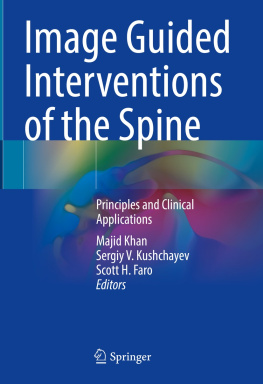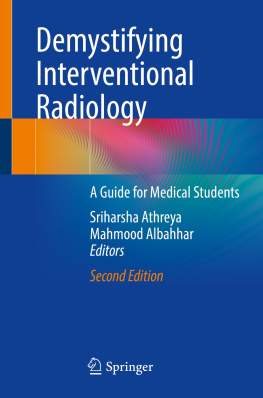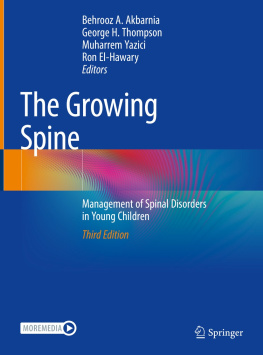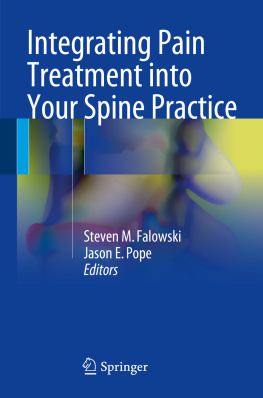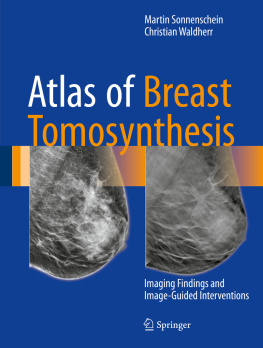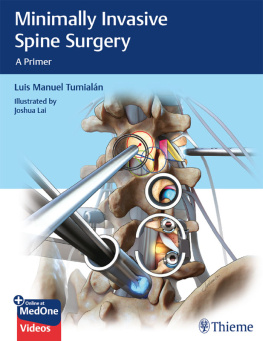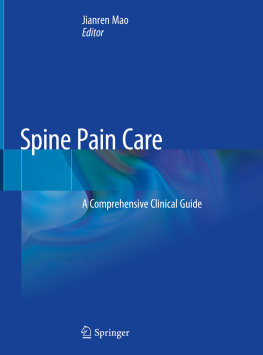Editors
Majid Khan , Sergiy V. Kushchayev and Scott H. Faro
Image Guided Interventions of the Spine
Principles and Clinical Applications
1st ed. 2021

Logo of the publisher
Editors
Majid Khan
Thomas Jefferson University, Philadelphia, PA, USA
Sergiy V. Kushchayev
Moffitt Cancer Center, Tampa, FL, USA
Scott H. Faro
Thomas Jefferson University, Philadelphia, PA, USA
ISBN 978-3-030-80078-9 e-ISBN 978-3-030-80079-6
https://doi.org/10.1007/978-3-030-80079-6
Springer Nature Switzerland AG 2021
This work is subject to copyright. All rights are reserved by the Publisher, whether the whole or part of the material is concerned, specifically the rights of translation, reprinting, reuse of illustrations, recitation, broadcasting, reproduction on microfilms or in any other physical way, and transmission or information storage and retrieval, electronic adaptation, computer software, or by similar or dissimilar methodology now known or hereafter developed.
The use of general descriptive names, registered names, trademarks, service marks, etc. in this publication does not imply, even in the absence of a specific statement, that such names are exempt from the relevant protective laws and regulations and therefore free for general use.
The publisher, the authors and the editors are safe to assume that the advice and information in this book are believed to be true and accurate at the date of publication. Neither the publisher nor the authors or the editors give a warranty, expressed or implied, with respect to the material contained herein or for any errors or omissions that may have been made. The publisher remains neutral with regard to jurisdictional claims in published maps and institutional affiliations.
This Springer imprint is published by the registered company Springer Nature Switzerland AG
The registered company address is: Gewerbestrasse 11, 6330 Cham, Switzerland
Preface
Image-guided interventions of the spine have evolved over time from being just a modality primarily used for biopsies to ones that are currently being considered in the treatment paradigm for complex spine pathologic conditions. We must constantly progress our methods and push our research and clinical teams to discover and execute newer and more efficient ways of minimally invasive techniques; indeed, we are under tremendous pressure from allied specialties, such as neurosurgery and orthopedic surgeries, which are devising more minimally invasive surgical options. Moreover, osteoporosis and obesity are on the rise, thereby significantly increasing the number of vertebral compression fractures and prompting the early onset of back pain and early development of spine degenerative changes. Although the advent of improved cancer chemotherapy and targeted radiation has resulted in greater patient longevity, we are simultaneously seeing the greater incidence of both spinal and extraspinal metastases, which require a multidisciplinary treatment approach in which interventional radiology forms an integral part. In the 1990s to 2000s, we witnessed the introduction of spine tumor ablation techniques with substantial improvements in vertebral cement augmentation devices, which has enabled these modalities to be recognized as part of the treatment paradigm for osseous spine metastases. Now, spine neuromodulation and insertion of pain pumps for pain palliation are done routinely for patients with chronic pain, and such advances have led to a decrease in oral narcotic usage and have somewhat allayed narcotic abuse at a time when narcotic abuse has accelerated into national crisis.
This issue is meant to familiarize the readers with the extensive and ever-expanding list of image-guided, spine-intervention procedures that are now available, used mostly as an adjunct and sometimes as an alternate treatment method to conventional treatment modalities in the spine. It explains, in detail, anatomic and vascular spine anatomy through clinical evaluation, pharmacologic requirements, and indications and contraindications of specific procedures. In addition, it covers a broad range of spine procedures discussed by experts in each field, including spine-augmentation techniques, tumor ablation, vascular interventional techniques, neuromodulation, epidural steroid injections, sacroiliac and facet joint injections, selective nerve root blocks, implanted drug-delivery systems, and epidural blood and fibrin patches for spontaneous cerebrospinal fluid leaks. Some of the described procedures, such as percutaneous treatment of lumbar stenosis and treatment of disc degeneration, are not being presently performed in the United States, butexpected to develop further in the next few yearsthey will gain critical attention in the United States.
Ultimately, this issue will be a useful tool to all physicians who treat back pain, including pain anesthesiologists, neurosurgeons, and orthopedic surgeons, neuroradiologists, body radiologists, and musculoskeletal interventional radiologists. Several of these procedures will also be valuable for general radiologists, particularly in private-practice settings. I have established advanced spine intervention programs at three large academic university hospitals and have observed firsthand the fast-paced growth in this field with ever-increasing patient referrals. Undeniably, rising exponentially is the need for both academic centers and private-practice groups to incorporate physicians with spinal interventional expertise with their practice groups. The fast-growing field of spine intervention has historically lacked a comprehensive guide, and this book promises to deliver what has been so desperately missing in this practice. Its many features should prove helpful for anyone starting a spine intervention service and should also serve as a reference book for experienced operators. Each chapter begins with a brief history of the procedure. All images provided in the book are state of the art. Patient selection criteria, indication, and contraindications are well delineated, and most chapters provide the reader with step-by-step instructions on how to perform each procedure, including the equipment and medications needed.
I sincerely hope this work will be useful in helping others establish and grow a minimally invasive, spine-interventional practice in their respective programs. This work has been a tremendously rewarding experience for me and allows me to intersect the diagnostic and interventional services to best help our patients.
Majid Khan
Philadelphia, PA, USA
Acknowledgments
I am grateful to my many colleagues who enabled me to have the time to write chapters and edit this book, including the many members of the Neuroradiology Division at Johns Hopkins and Thomas Jefferson University, including faculty, fellows, and residents. And of course, my work could not be complete without the support of my ever-caring and loving wife, Israh, and my two children, Mehak and Sameer, both of whom have helped to keep my mind focused and my writing clear.
Majid Khan, MBBS, MD
To my fantastic family, an endless source of inspiration and joy: my incredible wife, Yevgeniya, and my fabulous daughters, Kseniya and Sophia. And to my wonderful parents, Klavdiia and Valerian.

